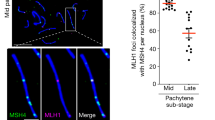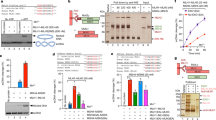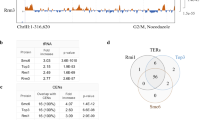Abstract
A double Holliday junction (dHJ) is a central intermediate of homologous recombination that can be processed to yield crossover or non-crossover recombination products. To preserve genomic integrity, cells possess mechanisms to avoid crossing over. We show that Saccharomyces cerevisiae Sgs1 and Top3 proteins are sufficient to migrate and disentangle a dHJ to produce exclusively non-crossover recombination products, in a reaction termed “dissolution.” We show that Rmi1 stimulates dHJ dissolution at low Sgs1–Top3 protein concentrations, although it has no effect on the initial rate of Holliday junction (HJ) migration. Rmi1 serves to stimulate DNA decatenation, removing the last linkages between the repaired and template DNA molecules. Dissolution of a dHJ is a highly efficient and concerted alternative to nucleolytic resolution that prevents crossing over of chromosomes during recombinational DNA repair in mitotic cells and thereby contributes to genomic integrity.
This is a preview of subscription content, access via your institution
Access options
Subscribe to this journal
Receive 12 print issues and online access
$189.00 per year
only $15.75 per issue
Buy this article
- Purchase on Springer Link
- Instant access to full article PDF
Prices may be subject to local taxes which are calculated during checkout





Similar content being viewed by others
References
Klein, H.L. & Symington, L.S. Breaking up just got easier to do. Cell 138, 20–22 (2009).
Ira, G., Malkova, A., Liberi, G., Foiani, M. & Haber, J.E. Srs2 and Sgs1–Top3 suppress crossovers during double-strand break repair in yeast. Cell 115, 401–411 (2003).
Heyer, W.D., Ehmsen, K.T. & Solinger, J.A. Holliday junctions in the eukaryotic nucleus: resolution in sight? Trends Biochem. Sci. 28, 548–557 (2003).
Gangloff, S., McDonald, J.P., Bendixen, C., Arthur, L. & Rothstein, R. The yeast type I topoisomerase Top3 interacts with Sgs1, a DNA helicase homolog: a potential eukaryotic reverse gyrase. Mol. Cell. Biol. 14, 8391–8398 (1994).
Wang, J.C. Cellular roles of DNA topoisomerases: a molecular perspective. Nat. Rev. Mol. Cell Biol. 3, 430–440 (2002).
Wu, L. & Hickson, I.D. The Bloom's syndrome helicase suppresses crossing over during homologous recombination. Nature 426, 870–874 (2003).
Chang, M. et al. RMI1/NCE4, a suppressor of genome instability, encodes a member of the RecQ helicase/Topo III complex. EMBO J. 24, 2024–2033 (2005).
Mullen, J.R., Nallaseth, F.S., Lan, Y.Q., Slagle, C.E. & Brill, S.J. Yeast Rmi1/Nce4 controls genome stability as a subunit of the Sgs1–Top3 complex. Mol. Cell. Biol. 25, 4476–4487 (2005).
Plank, J.L., Wu, J. & Hsieh, T.S. Topoisomerase IIIα and Bloom's helicase can resolve a mobile double Holliday junction substrate through convergent branch migration. Proc. Natl. Acad. Sci. USA 103, 11118–11123 (2006).
Wu, L. et al. BLAP75/RMI1 promotes the BLM-dependent dissolution of homologous recombination intermediates. Proc. Natl. Acad. Sci. USA 103, 4068–4073 (2006).
Bussen, W., Raynard, S., Busygina, V., Singh, A.K. & Sung, P. Holliday junction processing activity of the BLM–TopoIIIalpha–BLAP75 complex. J. Biol. Chem. 282, 31484–31492 (2007).
Raynard, S., Bussen, W. & Sung, P. A double Holliday junction dissolvasome comprising BLM, topoisomerase IIIalpha, and BLAP75. J. Biol. Chem. 281, 13861–13864 (2006).
Raynard, S. et al. Functional role of BLAP75 in BLM–topoisomerase IIIalpha-dependent Holliday junction processing. J. Biol. Chem. 283, 15701–15708 (2008).
Cejka, P. & Kowalczykowski, S.C. The full-length Saccharomyces cerevisiae Sgs1 protein is a vigorous DNA helicase that preferentially unwinds Holliday junctions. J. Biol. Chem. 285, 8290–8301 (2010).
Karow, J.K., Chakraverty, R.K. & Hickson, I.D. The Bloom's syndrome gene product is a 3′-5′ DNA helicase. J. Biol. Chem. 272, 30611–30614 (1997).
Weinert, B.T. & Rio, D.C. DNA strand displacement, strand annealing and strand swapping by the Drosophila Bloom's syndrome helicase. Nucleic Acids Res (2007).
Plank, J.L., Chu, S.H., Pohlhaus, J.R., Wilson-Sali, T. & Hsieh, T.S. Drosophila melanogaster topoisomerase IIIα preferentially relaxes a positively or negatively supercoiled bubble substrate and is essential during development. J. Biol. Chem. 280, 3564–3573 (2005).
Hanai, R., Caron, P.R. & Wang, J.C. Human TOP3: a single-copy gene encoding DNA topoisomerase III. Proc. Natl. Acad. Sci. USA 93, 3653–3657 (1996).
Fu, T.J., Tse-Dinh, Y.C. & Seeman, N.C. Holliday junction crossover topology. J. Mol. Biol. 236, 91–105 (1994).
Plank, J.L. & Hsieh, T.S. A novel, topologically constrained DNA molecule containing a double Holliday junction: design, synthesis, and initial biochemical characterization. J. Biol. Chem. 281, 17510–17516 (2006).
Plank, J. & Hsieh, T.S. Helicase-appended topoisomerases: new insight into the mechanism of directional strand transfer. J. Biol. Chem. 284, 30737–30741 (2009).
Bell, L. & Byers, B. Separation of branched from linear DNA by two-dimensional gel electrophoresis. Anal. Biochem. 130, 527–535 (1983).
Chen, C.F. & Brill, S.J. Binding and activation of DNA topoisomerase III by the Rmi1 subunit. J. Biol. Chem. 282, 28971–28979 (2007).
Shapiro, T.A. & Englund, P.T. The structure and replication of kinetoplast DNA. Annu. Rev. Microbiol. 49, 117–143 (1995).
Wang, J.C. DNA topoisomerases: Why so many? J. Biol. Chem. 266, 6659–6662 (1991).
Bzymek, M., Thayer, N.H., Oh, S.D., Kleckner, N. & Hunter, N. Double Holliday junctions are intermediates of DNA break repair. Nature 464, 937–941 (2010).
Chaganti, R.S., Schonberg, S. & German, J. A manyfold increase in sister chromatid exchanges in Bloom's syndrome lymphocytes. Proc. Natl. Acad. Sci. USA 71, 4508–4512 (1974).
Bachrati, C.Z., Borts, R.H. & Hickson, I.D. Mobile D-loops are a preferred substrate for the Bloom's syndrome helicase. Nucleic Acids Res. 34, 2269–2279 (2006).
German, J. Bloom syndrome: a mendelian prototype of somatic mutational disease. Medicine (Baltimore) 72, 393–406 (1993).
Kantake, N., Sugiyama, T., Kolodner, R.D. & Kowalczykowski, S.C. The recombination-deficient mutant RPA (rfa1-t11) is displaced slowly from single-stranded DNA by Rad51 protein. J. Biol. Chem. 278, 23410–23417 (2003).
Harmon, F.G., DiGate, R.J. & Kowalczykowski, S.C. RecQ helicase and topoisomerase III comprise a novel DNA strand passage function: a conserved mechanism for control of DNA recombination. Mol. Cell 3, 611–620 (1999).
Harmon, F.G. & Kowalczykowski, S.C. RecQ helicase, in concert with RecA and SSB proteins, initiates and disrupts DNA recombination. Genes Dev. 12, 1134–1144 (1998).
Gaillard, C. & Strauss, F. Ethanol precipitation of DNA with linear polyacrylamide as carrier. Nucl. Acids Res. 18, 378 (1990).
Bachrati, C.Z. & Hickson, I.D. Dissolution of double Holliday junctions by the concerted action of BLM and topoisomerase IIIalpha. Methods Mol. Biol. 582, 91–102 (2009).
Acknowledgements
We thank P. Janscak (University of Zurich), X. Veaute (Institute of Cellular and Molecular Radiation Biology, France), Tao-shih Hsieh (Duke University), B. Rad and A. Nimonkar (both University of California, Davis) for purified proteins and the members of the Kowalczykowski laboratory and W.D. Heyer (University of California, Davis) for their comments on the manuscript. This work was supported by the following grants: Swiss National Science Foundation Fellowship PA00A-115375 (P.C.), National Cancer Institute Award T32CA108459 (J.L.P.), Cancer Research UK (C.Z.B. and I.D.H.) and US National Institutes of Health grants GM-41347 and GM-62653 (S.C.K.).
Author information
Authors and Affiliations
Contributions
P.C., J.L.P. and S.C.K. conceived the general ideas for this study. All authors planned experiments and interpreted data; J.L.P. prepared DHJS; P.C. and C.Z.B. performed experiments. P.C., J.L.P. and S.C.K. wrote the manuscript; and all authors provided editorial input.
Corresponding author
Ethics declarations
Competing interests
The authors declare no competing financial interests.
Supplementary information
Supplementary Text and Figures
Supplementary Methods and Supplementary Figures 1–8 (PDF 6970 kb)
Rights and permissions
About this article
Cite this article
Cejka, P., Plank, J., Bachrati, C. et al. Rmi1 stimulates decatenation of double Holliday junctions during dissolution by Sgs1–Top3. Nat Struct Mol Biol 17, 1377–1382 (2010). https://doi.org/10.1038/nsmb.1919
Received:
Accepted:
Published:
Issue Date:
DOI: https://doi.org/10.1038/nsmb.1919
This article is cited by
-
Srs2 helicase prevents the formation of toxic DNA damage during late prophase I of yeast meiosis
Chromosoma (2019)
-
High-throughput creation and functional profiling of DNA sequence variant libraries using CRISPR–Cas9 in yeast
Nature Biotechnology (2018)
-
The control of DNA repair by the cell cycle
Nature Cell Biology (2017)
-
Smc5/6 complex regulates Sgs1 recombination functions
Current Genetics (2017)
-
Visualization of recombination-mediated damage bypass by template switching
Nature Structural & Molecular Biology (2014)



